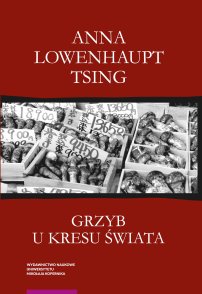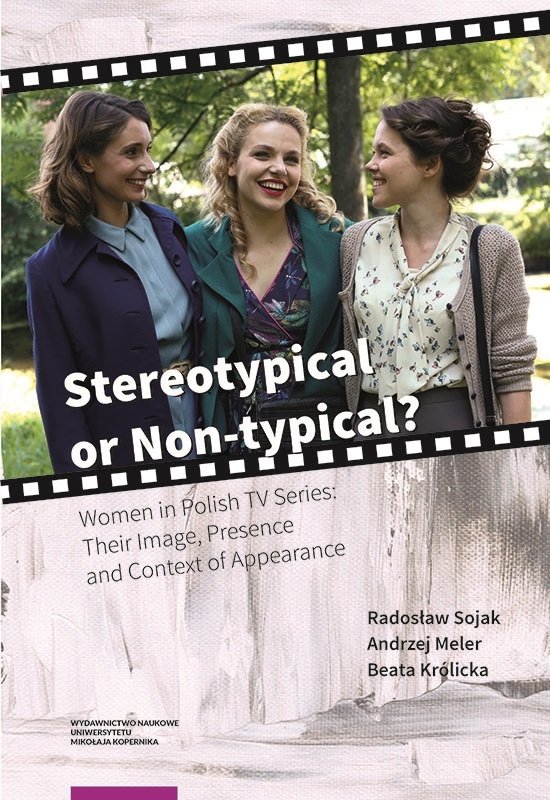Socjolog z nieustanną inklinacją do myślenia teoretycznego, doktor habilitowany, adiunkt w Instytucie Socjologii UMK, stypendysta Fulbrighta na University of Virginia, Charlottesville oraz tygodnika „Polityka” w ramach akcji „Zostańcie z nami”; autor i współautor rozpraw Zagubiona rzeczywistość (z Danielem Wicentym), Paradoks antropologiczny (seria Monografie FNP) oraz Spełniona obietnica.
Stereotypical or Non-typical? Women in Polish TV Series: Their Image, Presence and Context of Appearance
The key objective of this work is to answer the question: To what extent do contemporary Polish TV series try to change stereotypes about women and to what extent do they preserve them? The analysis involved a total of eight series produced and broadcast by Telewizja Polska, TVN and Telewizja Polsat, grouped by genre into: (1) drama series – soap operas; (2) historical drama series; (3) crime dramas and (4) comedy series. The analysis included 76 episodes of the above series with a total length of 49 hours and 51 minutes.
The subject of quantitative analysis was the total speaking time of female characters and their visibility on the screen. The qualitative analysis was based on the identification of the most important gender stereotypes and their use in the series’ storylines. In the analysed series, female characters speak for one fifth of the time longer than male characters and are visible on the screen 15% longer than male characters.
The dominant plots in the sample are issues of interpersonal relationships, i.e. partner relationships, emotional and sexual relationships (29%) and casual social relationships (meetings, visits, parties – 26%). Together, both contexts account for 55% of the time. Their analysis establishes (with a few exceptions) the most prevalent cultural stereotypes about women, including in particular: greater emotionality, strong focus on family and home matters (but not necessarily childcare), and general life orientation on building lasting interpersonal relationships. Due to the requirements of the plot, these stereotypes are nevertheless broken through. In particular, women often turn out to be resourceful and entrepreneurial. The analysis of stereotypes also indicates that the introduction of women into traditionally male roles is much easier than introducing men into roles traditionally considered female.
Table of Contents
Preface (Witold Kołodziejski) / 9
Selected Activities of the National Broadcasting Council for Equality and Combating Harmful Stereotypesin the European Context (Agnieszka Wąsowska) / 13
Introduction / 29
Chapter 1. Methodology and Theoretical Background / 33
Research Material / 33
Situational Contexts of the Exposure of the Characters / 35
Stereotypes about Women / 39
Coding Procedure / 48
Chapter 2. With Family and Friends – the General Image of Women in the Series / 53
Active Exposure in the Series / 53
Passive Exposure in the Series / 55
Contexts in the Series / 56
Chapter 3. In the Search of Everyday Balance – Women in Drama Series (Soap Operas) / 59
Convention in Drama Series / 59
Stereotypes, Roles and Relations in Drama Series / 61
Active Exposure in Drama Series / 65
Active Exposure in ‘M Jak Miłość’ / 66
Active Exposure in ‘Pierwsza Miłość’ / 67
Passive Exposure in Drama Series / 67
Passive Exposure in ‘M Jak Miłość’ / 69
Passive Exposure in ‘Pierwsza Miłość’ / 706
Contexts in Drama Series / 71
Contexts in ‘M Jak Miłość’ / 73
Contexts in ‘Pierwsza Miłość’ / 75
Chapter 4. Reconstructions of the Past – Women in Historical Drama Series / 79
Convention in Historical Drama Series / 79
Stereotypes, Roles and Relations in Historical Drama Series / 82
Active Exposure in Historical Drama Series / 88
Active Exposure in ‘Korona Królów’ / 88
Active Exposure in ‘Wojenne Dziewczyny’ / 89
Passive Exposure in Historical Drama Series / 90
Passive Exposure in ‘Korona Królów’ / 91
Passive Exposure in ‘Wojenne Dziewczyny’ / 92
Contexts in Historical Drama Series / 93
Contexts in ‘Korona Królów’ / 96
Contexts in ‘Wojenne Dziewczyny’ / 99
Chapter 5. Equality in the World of Crime – Women in Crime Dramas / 103
Convention in Crime Dramas / 103
Stereotypes, Roles and Relations in Crime Dramas / 106
Active Exposure in Crime Dramas / 112
Active Exposure in ‘Diagnoza’ / 112
Active Exposure in ‘Pułapka’ / 113
Passive Exposure in Crime Dramas / 114
Passive Exposure in ‘Diagnoza’ / 115
Passive Exposure in ‘Pułapka’ / 116
Contexts in Crime Dramas / 117
Contexts in ‘Diagnoza’ / 119
Contexts in ‘Pułapka’ / 122
Chapter 6. Funny and Go-Getting – Women in Comedy Series / 125
Convention in Comedy Series / 125
Stereotypes, Roles and Relations in Comedy Series / 127
Active Exposure in Comedy Series / 132
Active Exposure in ‘Dziewczyny ze Lwowa’ / 132
Active Exposure in ‘Przyjaciółki’ / 133| 7
Passive Exposure in Comedy Series / 134
Passive Exposure in ‘Dziewczyny ze Lwowa’ / 135
Passive Exposure in ‘Przyjaciółki’ / 136
Contexts in Comedy Series / 137
Contexts in ‘Dziewczyny ze Lwowa’ / 139
Contexts in ‘Przyjaciółki’ / 141
Comparative Analysis – Conclusions / 143
References / 153
List of Tables / 159
List of Figures / 161
Radosław Sojak
- Stereotypowe czy nietypowe? Wizerunek kobiet w polskich serialach – sposób prezentacji, obecność, konteksty
- Szara strefa przemocy - szara strefa transformacji? Przestrzenie przymusu
- Transformacja podszyta przemocą. O nieformalnych mechanizmach przemian instytucjonalnych
- Arystokraci i rzemieślnicy. Synergia stylów badawczych
Andrzej Meler
- Stereotypical or Non-typical? Women in Polish TV Series: Their Image, Presence and Context of Appearance
Beata Królicka
Powiązane

Matki i córki. Relacje rodzinne i artystyczne w autobiografiach kobiet po 1989 roku
Aleksandra Grzemska
Niewidzia(l)ne. Kobiety i historia Uniwersytetu Mikołaja Kopernika w Toruniu
Aleksandra Derra, Anna Maria Kola, Wojciech Piasek
Rytuały medialne w komunikowaniu masowym. Przypadek polskich telewizyjnych serwisów informacyjnych Fakty TVN i Wiadomości TVP
Aleksandra Seklecka
Kobiece ciało - kobieca psychika. Ja-cielesne a psychospołeczne funkcjonowanie młodych kobiet
Lidia Anna WiśniewskaInne z tej kategorii

Drugie pokolenie obozowe. Pamięć i doświadczenie potomków polskich więźniów niemieckich nazistowskich obozów koncentracyjnych
Maria Buko
Współczucie dla innych wśród studentów kierunków medycznych i niemedycznych
Małgorzata Fopka-Kowalczyk
Grzyb u kresu świata
Anna Lowenhaupt Tsing






